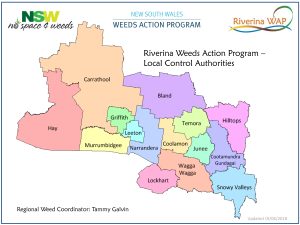The NSW Weeds Action Program 2015-2020 (WAP1520) follows, and builds on, the successful implementation of the NSW WAP 2010-2015. It is a NSW Government initiative to reduce the impact of weeds through implementation of the NSW Biosecurity Strategy 2013-2021 (the Biosecurity Strategy) and the NSW Invasive Species Plan 2018-2021 (ISP).
The Biosecurity Strategy outlines how government, industry and the community need to work together to identify, minimise, respond to and manage biosecurity risks, including weeds. It is based on the principle that biosecurity is a shared responsibility.
The ISP provides a state-level framework for the coordinated and cooperative management of invasive species, including weeds. It complements other existing strategies, in particular the Biosecurity Strategy and the Australian Weed Strategy.
WAP1520 demonstrates the Government’s commitment to the ISP through:
- developing state, regional and local processes to assist in the timely detection of and quick response to new weed incursions;

- supporting development of integrated, cooperative, cross-disciplinary, cross-jurisdictional programs;
- supporting prioritisation of weed management activities to achieve the greatest benefit;
- supporting effective and targeted on-ground risk mitigation for high priority weeds;
- developing and promoting proven strategies that foster long term behaviour change and result in increased community ownership of,
and involvement in, effective weed management; - supporting programs that implement integrated weed management systems;
- improving the knowledge base for weed management, in particular to influence the community, industry and other stakeholders;
- monitoring the implementation of the ISP and weed management generally; and
- promoting the use of cost-sharing arrangements to forge effective and strong partnerships.
Regional sub-programs must: contribute to the ISP either directly or through a Regional Strategic Weed Management Plan (RSWMP); demonstrate that the project team is using an integrated and coordinated approach across the region; demonstrate effective engagement with multiple stakeholders, to create productive partnerships that deal with Biosecurity Risk and Biosecurity Impact management.
The Riverina WAP will see implementation of 9 ISP key objectives with the following resources:
- Program Logic – is the rationale behind a program – a picture of why and how you believe a program will work.
- High Risk Species – a quick reference to the high risk (HR) species in the Riverina region – all ‘alert’, ‘eradication’ and ‘destroy infestations’ as per the NSW WRM system.
- Regional Inspection Policy – provides a minimum standard that ensures consistent policy and procedural framework for all LCAs to follow. The inspection program aims to detect new and emerging weeds before they become established in the region. Early detection and rapid response offer the most strategic and cost effective form of weed management. Consistency in the inspection policy across the region is critical for effective weed management.
- Communication Strategy – outlines the major communication, extension, training and education activities of WAP project partners. It will allow for greater coordination of activities and in turn lead to more successful awareness campaigns across the region.
- Rapid Response Plan – ensures a consistent approach to the management of new incursions of HR species throughout the Riverina. When a new incursion is found, this plan outlines specific procedures and recommended actions to be undertaken.
- MERI plan – monitors and evaluates the impact and achievements of the project, report on these and offer recommendations for improvement.
- New Incursion Plans (NIPs) – ensure a consistent approach and response to the surveillance, identification and management of new incursions of HR species throughout the Riverina. As new incursions are discovered across the region and plans of management required for specific species; a NIP is developed. To date we have NIPs for Alligator weed, Boneseed and Fireweed that will need reviewing 2018.
- New Incursions of high risk species – details all new incursions of HR species on record for the Murray & Riverina regions. It will be updated as new incursions are identified.
- High Risk Pathways & Sites – in 2016 Local Control Authorities (LCAs) identified HR Pathways and Sites within their boundary and ranked them according to previous incursions and potential risk. This is an internal working document that is updated as needed.
- High Risk Pathways & Sites Management Plan – defines and identifies HR pathways and sites; prevents new weeds from establishing through surveillance of these areas; and reduces existing weeds from spreading via HR pathways.
- Vehicle Hygiene Protocol – ensures a consistent approach across the Riverina towards vehicle hygiene.
- Performance Points – HR Pathways – Kochia, Early Detection Capabilities Developed & Implemented, High Risk pathways – Red Guide Posts.
Note: there are two separate WAP1520 programs – Murray and Riverina. Riverina WAP 2010-2015 was a combined program for these two areas.
For further details on the Riverina WAP 2015-2020 please contact Tammy Galvin – Regional Weed Coordinator [email protected]
